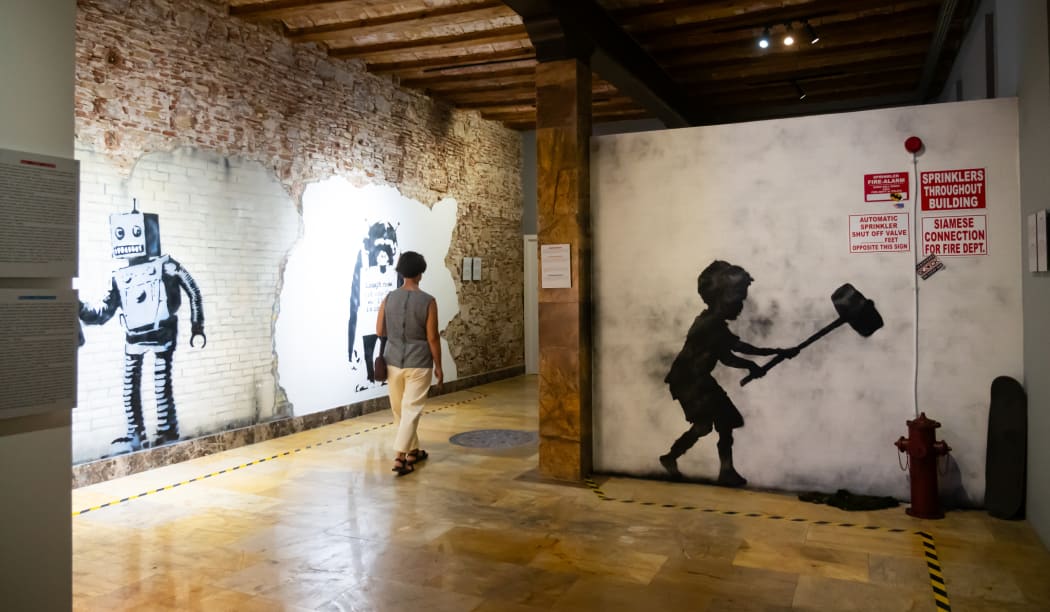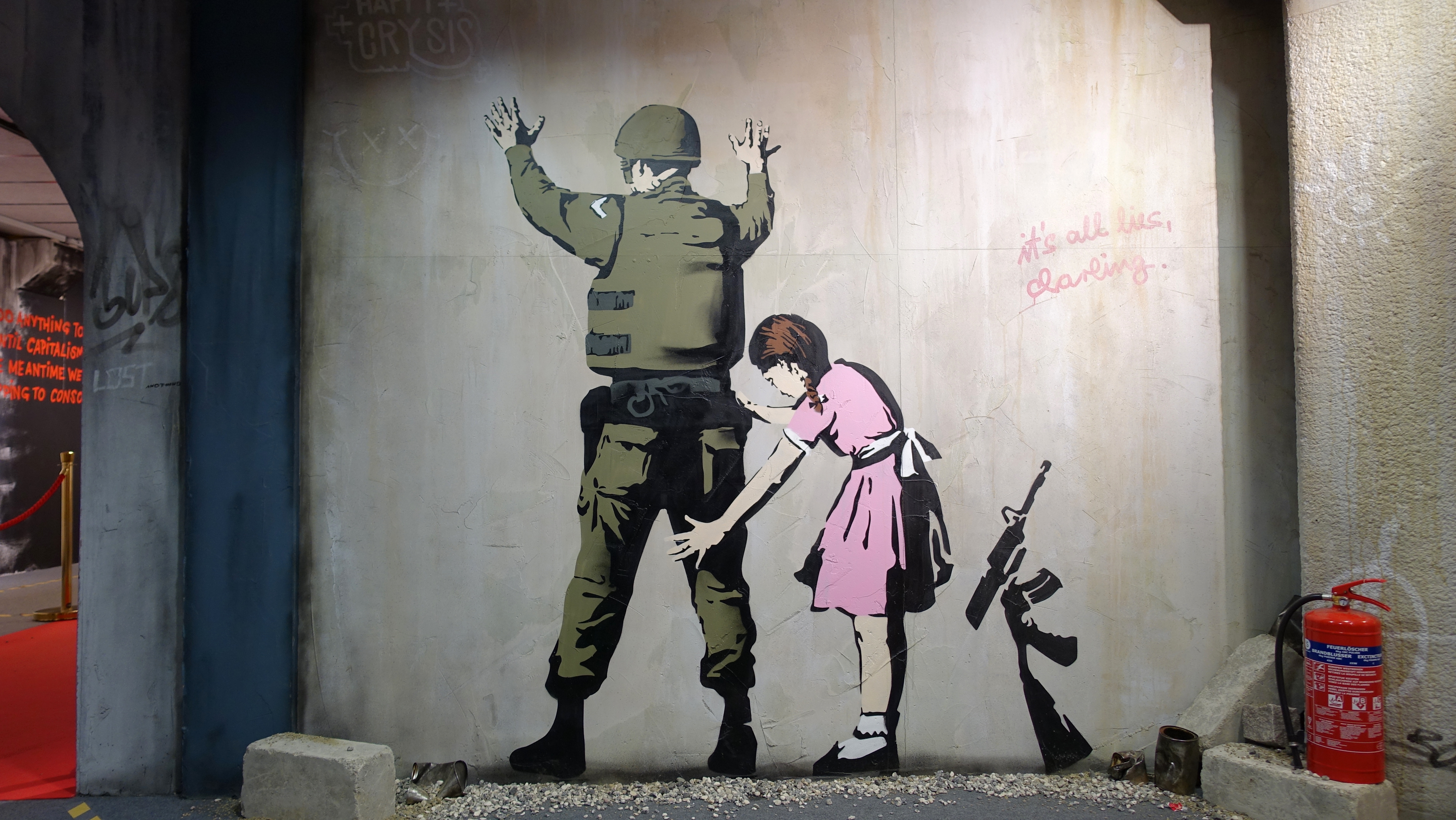
Banksy at the London Zoo
Friends is on the television, Nirvana is playing on the radio, and street art is quickly becoming a global phenomenon; and the time period? Well, it's the early 1990s, of course.
And if you looked closely enough, you might have seen a hooded figure roaming the cobblestone streets of Bristol, England, vandalizing walls, leaving his mark, and evolving into the icon he is today. That figure is Banksy, the anonymous street artist who continues to make headlines for his public murals, which often carry politically charged messages.
Today, the name Banksy has become synonymous with street art, and his work continues to influence the latest trends in the art market. Since his first act of spray-painting walls in Bristol during the 1990s, the artist has consistently challenged societal norms.
In recent Banksy news, the artist has returned to the London streets, painting a series of animal-themed works around the English capital. What BBC News is calling "Nine Days of Banksy" concluded on August 9, 2024, when a gorilla painting appeared on the gates of the London Zoo.
Nine Days of Banksy
For the first nine days of August, Banksy crept the streets around London, England, sneakily painting during the night.
The first work emerged in South-West London, with Banksy painting a goat looking over falling rocks in Richmond's Kew Green. In the days that followed, the artist's animal-themed paintings continued to appear. Two elephants, three monkeys, and a roaring wolf materialized daily, one after another. Then came several pelicans eating fish, a large cat mid-stretch, a school of fish, and a rhinoceros mounting a car-each in different parts of the city.

Banksy Rhino on Westmoor Street in Charlton" by Raph_PH, licensed under CC BY 2.0 via Wikimedia Commons.

"Guildhall Yard" by Matt Brown, licensed under CC BY 2.0 via Wikimedia Commons.
Banksy completed his final act on the gates of the London Zoo, where he stenciled an ape releasing animals, birds, and a seal from underneath a dark tarp.

"Banksy artwork at London Zoo" by Raph_PH, licensed under CC BY 2.0 via Wikimedia Commons.
Immediately, people began asking: What is the meaning behind the graffiti artist's street murals?
The Significance of Banksy's London Zoo Piece
Regarding Banksy's latest trending murals of August 2024, people have yet to uncover the ultimate truth. However, by analyzing the similarities among the artworks, we can attempt to suggest the meaning behind Banksy's graffiti murals.
Karen Ho, in the ArtNews article "Ninth Banksy Artwork in Nine Days Discovered at London Zoo," suggests that the artworks are an attempt to cheer people up during the current global situation. According to Ho, Banksy's "works cheer people with a moment of unexpected amusement, as well as gently underline the human capacity for creative play, rather than for destruction and negativity."
Others believe that the animal-themed graffiti works represent the primitiveness of society, animal activism, incarceration, or even relate the animal themes to ancient proverbs. For instance, some suggest that Banksy's monkeys represent "the 'wise monkeys' in the Japanese proverb of 'see no evil, hear no evil, speak no evil'" (BBC News). Some have even pointed to the Israel-Gaza conflict, interpreting the animals as speaking out against persecution.

“Banksy’s Monkey Business” — Banksy artwork on Brick Lane, London, August 2024. Licensed under CC BY-SA 2.0. Photo by Loco Steve via Wikimedia Commons.
At the end of the day, Banksy's artistic intention remains as anonymous as the artist unless he chooses to reveal it. The best people can do is hypothesize, base suggestions on the formal attributes of his pieces, and go from there.
It's clear that Banksy attempts to convey a message through his work. But the beauty of the street artist's creations lies in viewers drawing their own conclusions, sparking new conversations and debates about global issues, and using his work as forms of political activism.
Ultimately, the "Nine Days of Banksy" exemplifies the contemporary artist's signature approach: using humor and simplicity to deliver powerful social and political messages.
Is it Possible to Uncover Banksy's Artistic Intention?
The answer to that question is tricky. Banksy is an anonymous figure who has never explicitly stated his artistic intention. However, there are enough clues within his artworks for the public to generally agree on the same analysis.
Throughout his career, Banksy has maintained a consistent approach, focusing on themes of resistance, critiques of consumerism and capitalism, and the perspective of marginalized groups through political satire. This approach is reminiscent of the Young British Artists movement of the 1990s, which also challenged traditional art norms and embraced controversial forms. As a result, the public has concluded that Banksy's public murals embody a clear challenge to global authority and advocate for change.
Since the late 1990s, Banksy has become synonymous with political activism and revolutionary displays of street art. With infamous works like "Girl With a Balloon" and "Rage, the Flower Thrower," when a Banksy piece appears, people are quick to suggest their own interpretations of Banksy's political beliefs. Similarly, with the "Nine Days of Banksy," the public continues to dissect his animal-themed street art, searching for deeper meaning within each stroke of his stencil.

Stimmungsbilder1 - stock.adobe.com
Ultimately, the "Nine Days of Banksy" serves as a testament to the artist's ability to provoke thought and stir debate. Whether these animal-themed works are intended to comment on society's primal instincts, challenge the notion of captivity, or simply offer a moment of light-heartedness in a turbulent world, their true meaning remains open to interpretation.
What is clear, however, is that Banksy's work continues to challenge viewers to reflect on the world around them. By leaving his work open to multiple interpretations, Banksy ensures that his art remains relevant, engaging, and deeply connected to the social and political discourse of our time.
The Banksy Effect
The global acceptance of Banksy's urban art and illegal acts of vandalism as a respected art form has transformed the art world's perception of street art as fine art. Banksy's influence can be seen in the rising prominence of public art in urban environments, as well as in the growing demand for street art within the collectors' market.
Over the years, Banksy has played a crucial role in elevating street art's status in the collectors' market. His pieces fetch millions at auctions, with collectors viewing his works not only as cultural statements but also as valuable investments. This movement has pushed street art into the realm of fine art, where graffiti and other forms of street expression are now recognized for their artistic and financial worth.
Banksy at Art Gallery Carousel Fine Art
At our gallery, we represent a selection of urban and street artists who, like Banksy, bring powerful narratives and unique perspectives to their work. Artists such as Mr. Brainwash, Onemizer, and others have carved out their own spaces within this genre, offering collectors a chance to own pieces that are both visually compelling and rich in cultural significance. As the art market continues to evolve, these artists remain at the forefront of the latest trends, contributing to the dynamic and ever-changing landscape of contemporary art.
The level of fame Banksy has achieved reflects the increasing value of street art in the art world. As the market continues to grow, acquiring works from our collection allows collectors to add visually striking pieces to their portfolios while investing in the evolving narrative of contemporary art.
The End of Nine Days of Banksy?
Ultimately, "Nine Days of Banksy" allowed the contemporary artist to capture the public's attention. By allowing the public to discern their own interpretations, Banksy has also ensured that various topics are brought back into the global conversation. The ongoing discourse surrounding his works demonstrates the lasting impact of controversial art on society and its role in shaping public opinion. These insights provide valuable market information on how collectors and enthusiasts interpret and value street art in the contemporary landscape.
What makes "Nine Days of Banksy" significant is the artist's ability to provoke thought and inspire dialogue, reflecting his unique approach to art. His public works challenge viewers to engage with deeper social and political issues. These discussions not only enrich our understanding of Banksy's artistry but also offer valuable market insights into how art influences culture and commerce.
Banksy's influence on the art world cannot be overstated. By elevating street art to a respected and sought-after form of fine art, he has paved the way for a new generation of artists who continue to push boundaries and redefine what art can be.

